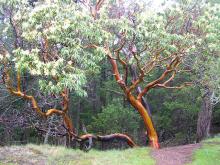
Image Credit: Brewbooks
Common name(s): Pacific Madrone, bearberry, strawberry tree, madrono, madrona, arbutus
General bloom time: flowers March-June; berries mature in the autumn
Identification: bark is reddish-brown and when mature it peels away from the trunk; grows to heights up to 40 meters
Leaves: broad-leaf simple, alternate, evergreen, shiny and large
Flowers: small flowers (6 mm), pink, fragrant, and urn-shaped
Fruit: small berries (0.6-1.2 cm in diameter), round, bright orange to red with many seeds
Habitat: can withstand drought, temperature extremes, shade and elevation so they are able to survive in a number of habitats; generally found in poor soil with poor water retention during the summer months; often in rocky outcrops.
Ecology: birds eat the berries, hummingbirds feed on the nectar, supports beneficial insects.
%2c_Jacksonville_Woods/index.jpg?itok=sIYy8CDf)
Image Credit: bobrpics
Fun Facts:
- Can live 400-500 years
- Bark was used as medicine in tea to soothe stomach-aches and the leaves as ointment for cuts
- The bark can be used to tan leather
References: Seagrave, John. “The Biography of the Pacific Madrone.” 11-Dec-2002 1-9. 18-Jan-2008.